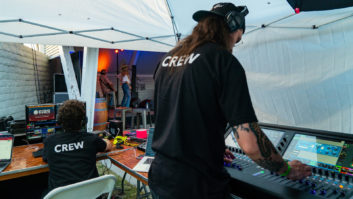
With a new album, Cleopatra, debuting at Number One in both the Billboard 200 and UK Album Charts in April, hometown heroes The Lumineers returned to Denver to play two sold-out shows at the famed Red Rocks Amphitheater in June 2016. On the first night, the band mixed in songs from the new album, including the title track, with old favorites like “Ho Hey” and a cover of Bob Dylan’s “Subterranean Homesick Blues.”
Working front-of-house for the band is Josh Osmond, who has been with The Lumineers since September 2013.
For the 2016 summer tour, Osmond is mixing on the new Avid S6L-32D. He appreciates the sample rates and how the design of the new console makes the workflow easier. “Obviously having a desk that can run at the higher sample rates is pretty essential now with the digital format, so that is great,” he explains. “The input and output count has been significantly increased, which makes the console very flexible when you have a band that is constantly changing or adding to what they want to have presented in their live performance, and the general workflow of the desk is as good as it gets. I can pretty much get anywhere I need to go with one touch of a button or screen. I also love the fact that I can attach a specific layout of faders/channels to a snapshot and have the essential inputs be recalled for each song in the set.”
Osmond relies on stock 64-bit AAX plug-ins on the Avid, such as the Pro Subharmonic, and the multiband compressor that he uses on the main vocal, electric and upright bass, cello, and acoustic and electric guitars. During the summer in Europe, he started using the Sonnox Oxford Reverb and Oxford Dynamics, as well as the Softube Tube-Tech. He also likes to use a variety of outboard gear.
“I have really found that essential to helping open up the stereo image, as well as warming up and cleaning up some of the inputs,” Osmond says of the outboard. “I have a TC Electronic M5000 that I use for snare and tom reverbs. I have two Bricasti Design M7s that I use for vocal reverb and some special effect reverbs. I have an Alan Smart Research C2 compressor that I use on the main left and right bus; I do very subtle 2-to-1 compression, and it really allows the mix to stay under control when things want to get derailed. I use three Empirical Labs Distressors—one on the lead vocal, one on electric bass, and one as a spare—and two Summit DCL-200s for parallel compression over the entire drum subgroup. This really allows the drums to drive the mix without overpowering it.”
When preparing for the tour, Osmond spent a lot of time listening to Cleopatra and tried to duplicate the album for his mix, and uses reverb to “make some inputs sound bigger. Luckily, this is a very organic band, and almost every input out of the 64 we use is a live mic/instrument. There is no track or playback, so that is really refreshing. My main goal is to basically create as best I can a three-dimensional space for everything to live in. We have lots of acoustic instruments, so everything needs to sound natural.”
The band carries its own P.A., a Meyer Sound system provided by Sound Image. They flew 14 LYON speakers per side, four 1100-LFCs per side, and added eight 900-LFCs ground-stacked per side, three CQ-2s per side for front fill, and four MINA boxes as lip fill. The system was powered by one master Galileo Callisto 616 at FOH and three Galileo Callisto 616s on either side of the stage.
Osmond doesn’t have the benefit of a system tuner for this tour, but in the future will have a dedicated system tech so he can concentrate on the mixing duties. His prior experience with system tuning allows him to tune things with Smaart v.7.

Front-of-house engineer Josh Osmond is mixing The Lumineers on an Avid S6L-32D. Photo: Todd Berkowitz
“I like to use upwards of five measurement microphones when shaping the arrays. This allows me to look at the frequency response of the system at various locations of the venue all at the same time. From there, I can do some broad shaping to the system to get the response to be as consistent as possible across the vertical plane of the venue. My rule of thumb when tuning is to EQ first, then time-align. Obviously, any parametric filter that you put into your system will add a small amount of latency, so it’s important to EQ a zone first and then look at timing relative to another already EQ’d zone. That way, you know that the phase response will be accurately compared to each other for the most part.”
The mic setup includes an Audix D6 and Shure Beta 91A for drums, a Neumann KMS 100 on top and a Telefunken M80 on the bottom of the snare, and a Shure KSM141 on hi-hat and ride. There is a Shure 181/C on the rim of the kick drum, toms are Sennheiser e 904s, overheads are Neumann KM 184s, and there are a Shure Beta 91A, Sennheiser e 904, and Sennheiser e 602 for auxiliary drums that are a combination of kick and toms. Guitars are a combination of Shure KSM313s and Telefunken M81-SHs. Vocals are a combination of Shure KSM8s and Shure SM58s. Osmond also has Shure KSM137s for FOH audience mics for his recordings.
Handling monitor duties is Brad Galvin, who has been with the band since 2012. Galvin is mixing on a DiGiCo SD5, having transitioned from using the Avid Venue Profile.
“I really like that I can have anything anywhere on the console, as well as having multiples of the same channel anywhere on the surface,” Galvin says. “I utilize the multi channels a fair amount since I have performers with multiple dedicated mics where I have a single fader to control the overall level, but can quickly open it up and adjust all the individual channels assigned to them. I then use a macro to swap which input is live at any given time. I also use multis on my toms and all of my various overhead mics.”
Galvin doesn’t use plug-ins, and likes to use effects sparingly on his mix. “I honestly try not to use a lot because I want the band to have a good representation of what they are giving me, and as much as I enjoyed having plug-ins with the Profile, I still used the least amount that I could. I do use a number of the tube emulations on the console to get a little bit of harmonic distortion on some inputs, but even those I use sparingly. I feel like it’s easy to go overboard when using plug-ins and it can often do more harm than good. If the source sounds good, and the mic picks it up properly and the console preamp and single path sounds good, I simply don’t need all that extra stuff.”
For the monitor mixes, most of the band is on in-ears. Singer and guitarist Wes Schultz gets guitar and vocal and vocal verb “riding on top a bit,” according to Galvin. “Jer [Jeremiah Fraites] gets a lot of drums with a lot of reverb and a good mix of everything else just below that, and Neyla [Pekarek] mainly listens to cello and her vocal with the piano and bass there for tuning and guitars just below that.
“Wes’s vocal is somewhere between the guitars and bass/piano in her mix,” he continues. “Byron [Isaacs, bass player] gets a lot of bass, kick and snare, with just a touch of everything else to keep time and pitch for his vocals. Stelth [Ulvang, pianist] has both ears and the only wedge on the stage. Both mixes are similar. It’s mainly to feel some low-end vibration, and for the times when he will pull an ear out. Other than that he has a lot of keys, Rhodes and accordion in his mix. When he plays the mandolin and the acoustic guitar, it rides just above everything else, but not loudly. Other than that, he has a general mix of everything just underneath his own instruments.”




